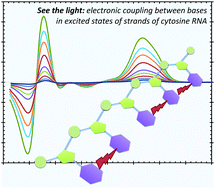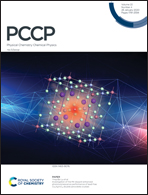On the delocalization length in RNA single strands of cytosine: how many bases see the light?†
Abstract
The interplay between multiple chromophores in nucleic acids and photosynthetic proteins gives rise to complex electronic phenomena and largely governs the de-excitation dynamics. Electronic coupling between bases in the excited states of single strands of DNA and RNA may extend over several bases and likely protects nucleic acids from harmful UV damage. Here we report on the coupling between bases in single RNA strands of cytosine and find that the excited state is delocalized over up to five bases at neutral pH, where all bases are non-protonated (i.e. neutral). Delocalization is over four bases at 278 nm excitation, while it involves five bases at shorter wavelengths of 188 nm and 201 nm. This is in contrast to only nearest-neighbour interactions for corresponding DNA strands as previously reported. The current results seemingly corroborate earlier findings of larger spatial communication in RNA than in DNA strands of adenine, but there is no obvious link between the overall structure of strands and delocalization lengths. RNA cytosine strands form a tight helix, while comparatively, adenine strands show less tight packing, also compared to their DNA counterparts, and yet exhibit even higher delocalisation.



 Please wait while we load your content...
Please wait while we load your content...